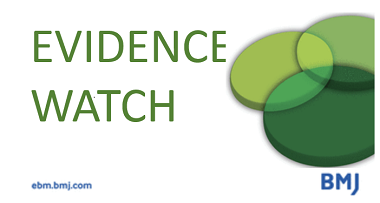Evidence suggests rooming-in should be the norm in hospitals but what factors will limit uptake
Carl Heneghan

Here’s what we selected this week:
Daily vs intermittent antituberculosis therapy for pulmonary tuberculosis in patients with HIV a randomized clinical trial. JAMA Internal Medicine, 178(4), 485–493. Bottom line: HIV-positive patients with pulmonary TB receiving antiretroviral therapy, do better with daily anti-TB regimen than three times a week dosing regimes.
Association of rooming-in with outcomes for neonatal abstinence syndrome: A systematic review and meta-analysis. 2018. JAMA Pediatrics, 172(4), 345–351. Bottom line: Opioid-exposed newborns rooming-in with mothers appears to lead to treatment with fewer drugs and had a significant reduction in length of stay.
Association of inhaled corticosteroids and long-acting muscarinic antagonists with asthma control in patients with uncontrolled, persistent asthma a systematic review and meta-analysis. 2018. JAMA, 319(14), 1473–1484. Bottom line: Use of long-acting muscarinic antagonists is associated with a lower risk of asthma exacerbations; however, the association may not be more significant than using long-acting bronchodilators
Out of these studies, the association of rooming-in with outcomes for neonatal abstinence syndrome caught my eye. I have to admit, I didn’t know what rooming-in meant. There is a rising incidence of withdrawal syndromes amongst infants after birth caused by in utero exposure to drugs of dependence (neonatal abstinence syndrome). Rooming in is the practice in hospitals of keeping the baby by the side of the mother or family’s bed whne issues such as dependence arises.
This systematic review of six studies (n=549) found that rooming-in reduced use of drugs, RR, 0.37 (95% CI, 0.19-0.71) and length of stay by a mean weighted difference of 10.4 days (95% CI, -16.84 to – 3.98 days). Sensitivity analysis reduced the heterogeneity around these effects. Three studies also reported inpatient costs were lower; qualitative analysis favoured rooming-in, as it seemed to increase breastfeeding rates and discharge.
This evidence would suggest that rooming-in should be the norm in hospitals given the reduction in length of stay. The size of the studies and the study designs, however, will affect uptake: one was retrospective, and five used a before and after design meaning there are real risks of confounding. However, the quality of the included studies was high. Also, the generalisability might be limited as they were done in only three countries: Germany, USA and UK.

BMJ Evidence-Based Medicine – original evidence-based research, insights and opinion
BMJ EBM accepts submissions of a wide range of article types, including original research, debate, analysis & opinion, and clinical spotlight.
Read more about BMJ EBM content in the Welcome to BMJ Evidence-Based Medicine Editorial.
Competing interests
Carl has received expenses and fees for his media work including BBC Inside Health. He holds grant funding from the NIHR, the NIHR School of Primary Care Research, The NIHR Oxford BRC and the WHO. He has also received income from the publication of a series of toolkit books. CEBM jointly runs the EvidenceLive Conference with the BMJ and the Overdiagnosis Conference with some international partners which are based on a non-profit model.